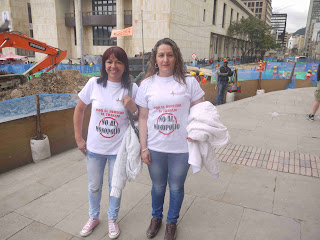 |
| Which is the line? Disputed seawaters between Colombia and Venezuela. (Image from Wikipedia) |
The gulf, outside the city of Maracaibo, is borderd on its western side by the La Guajira peninsula, and on the other by the Venezuelan mainland. Thru the gulf passes much of Venezuela's oil exports.
But one small patch of the gulf is not Venezuela's - according to Colombia. And that difference has been the source of disagreement since Venezuela separated from La Gran Colombia in 1831. Multiple treaties, negotiations and arbitrations haven't resolved the difference. And in 1987, the two nations even came close to war when a Colombian warship, the Corbeta Caldas, entered the disputed waters. Venezuela sent its own fleet of warships to confront it, and the crisis only ended after the secretary of the OAS and the president of Argentina intervened.
After that, the two countries established a binational commission to work out the dispute, but the commission hasn't met for the last seven years.
The difference centers on whether the maritime border is drawn as an extention of the land border, as Venezuela claims, or more to the eastward, as Colombia asserts. Part of the dispute hinges on the status of the Los Monjes Archipelago, a group of rocks inhabited by birds but not people (except for a Venezuelan military outpost), which are controlled by Venezuela, but have historically been claimed by Colombia. Do Los Monjes qualify as Venezuelan continental territory incluencing the border line?
The current dispute was triggered by another border dispute, between Venezuela and its eastern
 |
| Venezuela claims abouit two-thirds of the territory controlled by Guyana. (Image from Wikipedia) |
Guyana, whose very existence as a nation is threatened by Venezuela's claims, responded more aggressively, by canceling landing rights for a Venezuelan state airline, stranding a plane and passengers in the Guyanese capital. Venezuela seemed to back off after that. Colombia, for its part, sent a letter of protest and is still awaiting response.
The dispute has more than symbolic importance. The patch of waters borders the entrance to Maracaibo's port, and may contain oil or gas reserves.
Control of Carribbean maritime territory is a sore point for Colombia, after a ruling in 2012 by the International Court of Justice in The Hague giving Nicaragua sovereignty over large areas of sea around the San Andres archipelago, which belong to Colombia.
Some Colombian commentators suggest that Venezuela's provocative moves are intended to generate nationalism and distract the people from domestic troubles. Venezuela's economy is in free-fall, its crime rate has soared and the government faces parliamentary elections in December.
By Mike Ceaser, of Bogotá Bike Tours






















































